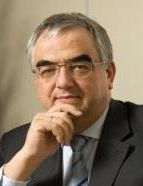 |
| Pharmacyclics CEO Robert Duggan |
Back in 2010, Pharmacyclics ($PCYC) had a promising leukemia candidate and a lengthy list of Big Pharma outfits jockeying for a partnership. Throughout months of meetings and negotiations, eventual winner Johnson & Johnson ($JNJ) wasn't the biotech's first choice, CEO Robert Duggan told FierceBiotech in January, but, as The Wall Street Journal lays out, J&J and its expansive approach to dealmaking won out in the end.
The end of the story is already well-told: The drug, ibrutinib, went on to snag three FDA breakthrough designations on its way to approvals for mantle cell lymphoma and chronic lymphocytic leukemia, and now it's slated to bring in about $1.3 billion a year at its peak. Lesser known, however, is how J&J muscled its way to the front of a scrum that included Novartis ($NVS) and Celgene ($CELG), eventually convincing Pharmacyclics that it could steer ibrutinib to a brighter future.
As WSJ's Jonathan Rockoff reports, Pharmacyclics was already in talks with potential partners for the drug when J&J research director Peter Lebowitz first flew in to take a hard look at ibrutinib. After poring over its data, Lebowitz returned to J&J headquarters as a sort of evangelist for the drug, eventually persuading Chief Science Officer Paul Stoffels and even CEO Alex Gorsky to trek out to Sunnyvale, CA, to sit down with Pharmacyclics and get to know the cancer therapy, according to WSJ.
 |
| J&J CSO Paul Stoffels |
And that personal touch paid off: Pharmacyclics agreed to a deal worth up to $975 million under which it'll split profits on ibrutinib, marketed as Imbruvica, and excitement over the drug's potential has sent the biotech's shares soaring, making Duggan a billionaire on paper.
But perhaps the biggest takeaway from WSJ's deep dive is how J&J has embraced dealmaking and external R&D to a greater degree than most of its Big Pharma competitors. While the industry has long been moving away from the insular drug development paradigms of yesteryear, J&J is ahead of the curve: As WSJ notes, in 2012, about one-third of Big Pharma's pipeline was discovered by another company; for J&J, the proportion was 50%.
That, like much of what's gone right in J&J's R&D operation over the past few years, is a credit to Stoffels. In 2009, he spearheaded a program called Project Playbook, under which J&J designated a few promising disease targets and then amassed all the relevant information on any drugs under development to treat them, WSJ reports.
That resulted in a matrix of potential licensing targets sorted by safety, efficacy and phase of development, and it was through Project Playbook that J&J first found ibrutinib. Same goes for daratumumab, a multiple myeloma treatment J&J licensed from Genmab for up to $1.1 billion, and ARN-509, the prostate cancer-fighting star of the company's $1 billion deal for Aragon Pharmaceuticals.
And J&J is hardly resting on its laurels, launching dealmaking outposts at hot spots around the world and incubating biotechs through its Janssen subsidiary, all in hopes of finding the next Pharmacyclics and starting this process all over again.
- read the WSJ article (sub. req.)